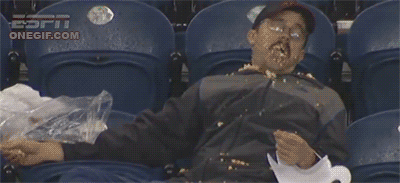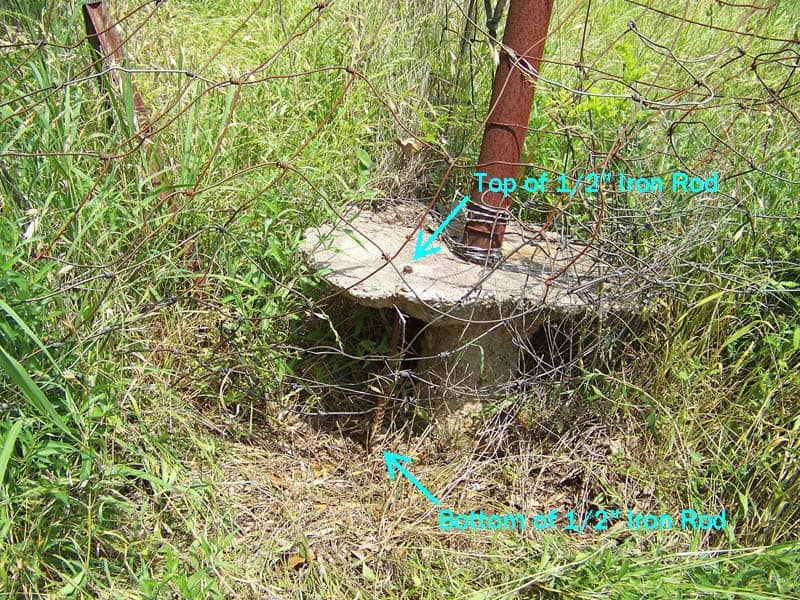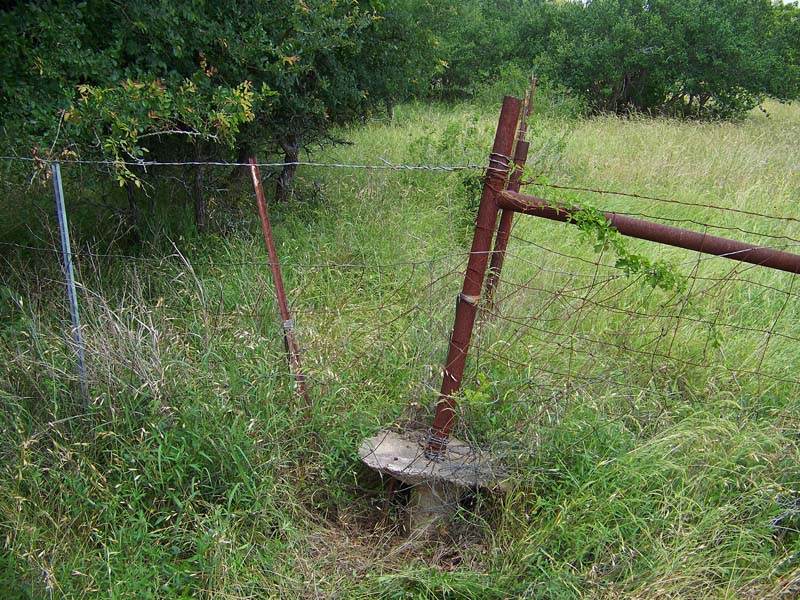In the vicinity of one of the corners of the senior tracts whose boundaries define the boundary of the remainder tract I'm surveying, I found this iron rod marker, a #4 rebar in concrete with scraps of old plastic surveyor's ribbon attached to it. Apparently, the fence post (what in some states would be known as the "original" fence corner) was set in concrete in a hole beside the rebar and the concrete ended up encasing the top of the rod. The rebar is the same pattern as other 1/2-inch iron rods found marking other corners of the tract that the public records indicate were placed in 1983. The survey was made before the conveyance and the land was then conveyed using a metes and bounds description prepared by the 1983 surveyor calling for this marker at the corner.
Here's the question: Do you consider the top or the bottom of the rod to mark the corner? I mean all we hear is "original monuments control" and this rebar would appear to be that originally set and described in the deed of record. So, presumably in that world the corner is either (a) the base of the rod, (b) the top of the rod (since that is visible), or some point between the two.
Or, might the corner be somewhere else?
I would be inclined to say that the monument has been disturbed and that the record metes and bound would hold. From the photo you provided it looks like the fence post, concrete and monument have either been pulled or eroded and are no longer in their original position or orientation.
John Putnam, post: 371542, member: 1188 wrote: I would be inclined to say that the monument has been disturbed and that the record metes and bound would hold. From the photo you provided it looks like the fence post, concrete and monument have either been pulled or eroded and are no longer in their original position or orientation.
Hold on. You mean that original monuments don't control if they have been disturbed? Should a land surveyor determine whether a monument has been disturbed, then? This sounds like Rocket Science when there is there is the 1983-vintage rebar right there in plain view.
I might dig a hole to the bottom of the rebar in hopes of finding where it may have been originally set. If it were to measure good I would be inclined to set a new rebar with associated numbers. In the same regard if you were to dig a hole and the top measured better I suppose you would have further "disturbed" it...
Around here, the mall and chisel (or Bosch hammer drill) would be fetched from the truck.
The concrete would be broken free of the rebar. Rebar would be plumbed and reflagged and life would go on.
Brian McEachern, post: 371545, member: 9299 wrote: I might dig a hole to the bottom of the rebar in hopes of finding where it may have been originally set.
Would a surveyor ever need to have any idea of what the ordinary errors of the survey that placed the rebar in 1983 were?
Robert Hill, post: 371546, member: 378 wrote: Around here, the mall and chisel (or Bosch hammer drill) would be fetched from the truck.
The concrete would be broken free of the rebar. Rebar would be plumbed and reflagged and life would go on.
So, you'd just accept the rebar as it is and report it as "found" with no further inquiry needed?
John Putnam, post: 371542, member: 1188 wrote: I would be inclined to say that the monument has been disturbed and that the record metes and bound would hold. From the photo you provided it looks like the fence post, concrete and monument have either been pulled or eroded and are no longer in their original position or orientation.
No, just because a monument has been disturbed doesn't mean the corner is lost and measurements are resorted to. If the original position of the monument can be found with acceptable evidence, the corner is existent.
As to the slightly disturbed rebar in concrete -
Really? Is this what they call a genuine surveying dilemma in Texas?
That corner isn't lost, heck it isn't even really disturbed, well, unless you are worrying about millimeters......
Good grief, if you really have your undies in a bunch over such a small "problem" hook the winch on the post and pull it back into position.
de minimus non curat lex
Kent McMillan, post: 371547, member: 3 wrote: Would a surveyor ever need to have any idea of what the ordinary errors of the survey that placed the rebar in 1983 were?
I am sure a surveyor would. However if a surveyor placed the rebar through the concrete fence post base at an angle like that then clearly I would not question the position of said rebar. I would have to, for all intensive purposes of the word, assume that the rebar was set straight up and down or as close to it as surveyorly possible. To me that would tell me that the surveyor intended for the bottom of the rebar to be in the same location as the top making a somewhat disturbed looking corner be the most precise at the base.
I'd study it. The hole and all. And SET a new rebar, TEMPORARY , at the ESTIMATED original location. Then, Go and shoot other points, of significance. From the other surveys. And, then, after studying it all, IF the computed point was close to my bar, I'd return, and use a compass, and box tape, to move over, SETTING the final bar. And pull my temporary. If the computed one was not reasonable, then I'd USE my temporary. But, only after careful study.
You asked, so those are my thoughts, from looking at your pic.
I might also use my shovel, and fill it in, so my new monument was actually set in something, not air.
N
Kent McMillan, post: 371548, member: 3 wrote: So, you'd just accept the rebar as it is and report it as "found" with no further inquiry needed?
Found Disturbed
Reconditioned or rehabilitated or reset. Whatever R word you prefer.
Around here, some fence builders and utility pole installers are known to pull the rebar and set post or pole then set the rebar about a foot from the post.
So you gotta think about things like that when reducing data.
It looks like an armadillo habitat : )
Okay, so far, only John Putnam has been observant enough to recognize that the "original fence corner post" is wildly disturbed. A land surveyor will be able to make that judgment. Someone who uncritically accepts anything they can find near a fence corner post? Maybe not so much.
Measurements demonstrate that the rebar was originally set to mark the corner in a location more than 5 ft. distant from where it is shown in the photo. You are looking at an entire welded steel pipe brace section that was pulled out of the ground, moved about 5 ft. East, and just set in some new holes on ground that didn't fit the profile of its previous location, which is why the corner post is canted so far out of plumb.
Does a land surveyor have to have some idea of what the expected errors in a survey were? Uh, hell, yes.
What did you find 5' from there?
Brian McEachern, post: 371559, member: 9299 wrote: What did you find 5' from there?
There was a newer galvanized steel pipe gate post set in the old post hole. The corner post of the welded pipe brace section was pretty clearly in that position originally. This is just a demonstration of why the ordinary errors of surveyors matter. Otherwise, aside from X-ray vision or ESP, how is a surveyor to discover that some monument has gone on walkabout? Stuff happens and to just uncritically accept whatever and wherever is a recipe for something unpleasant for all concerned.
Where's the dislike click ?
Kent McMillan, post: 371558, member: 3 wrote: Okay, so far, only John Putnam has been observant enough to recognize that the "original fence corner post" is wildly disturbed. A land surveyor will be able to make that judgment. Someone who uncritically accepts anything they can find near a fence corner post? Maybe not so much.
Measurements demonstrate that the rebar was originally set to mark the corner in a location more than 5 ft. distant from where it is shown in the photo. You are looking at an entire welded steel pipe brace section that was pulled out of the ground, moved about 5 ft. East, and just set in some new holes on ground that didn't fit the profile of its previous location, which is why the corner post is canted so far out of plumb.
Does a land surveyor have to have some idea of what the expected errors in a survey were? Uh, hell, yes.
Your photo in no way tells that story.
Now you are just being a jerk.
Robert Hill, post: 371564, member: 378 wrote: Where's the dislike click ?
Well, all I'm pointing out is how certain habits of the mind such as uncritically accepting whatever one finds wherever he or she finds it, basically act as blinders to other relevant inquiry. Stuff happens and measurements are yet another clue that a surveyor wants to pay attention to before just breaking some rebar out of the concrete around a fence post, pounding it into the ground, and returning to the office.
Kent McMillan, post: 371561, member: 3 wrote: Stuff happens and to just uncritically accept whatever and wherever is a recipe for something unpleasant for all concerned.
What if: whatever and wherever is all you got?

Dave Karoly, post: 371566, member: 94 wrote: Your photo in no way tells that story.
Now you are just being a jerk.
Hey, the first photo clearly shows a fence post obviously leaning out of plumb and its base raised above the grade to which it was evidently poured. The second photo shows a welded brace at right angles to the post and doesn't suggest any cause for any erosion. The other fence posts in the second photo in fact strongly suggest that there has been no erosion at all, that the corner post is unnaturally high. If the obvious first thought isn't "Hey, something's wrong here", the next should be "How far away from where the 1983 surveyor reported setting this rebar is it now?"
In an earlier thread, the whole notion or concept of ordinary errors was dismissed by some posters as irrelevant, presumably because they felt that they could tell just by *looking* at a monument whether it was disturbed or not. Well, this was an example that shows the limit of that mental habit.





